Top Rankings
Wilson County Schools School District ranks among the top 20% of public school district in North Carolina for:
Category
Attribute
Diversity
Most diverse schools (Top 1%)
Community Size
Largest student body (number of students) (Top 1%)
For the 2025 school year, there are 7 public middle schools serving 2,307 students in Wilson County Schools School District. This district's average middle testing ranking is 4/10, which is in the bottom 50% of public middle schools in North Carolina.
Public Middle Schools in Wilson County Schools School District have an average math proficiency score of 41% (versus the North Carolina public middle school average of 48%), and reading proficiency score of 47% (versus the 50% statewide average).
Minority enrollment is 73% of the student body (majority Black), which is more than the North Carolina public middle school average of 56% (majority Black and Hispanic).
Overview
This School District
This State (NC)
# Schools
25 Schools
882 Schools
# Students
10,216 Students
494,023 Students
# Teachers
614 Teachers
31,644 Teachers
Student : Teacher Ratio
17:1
17:1
District Rank
Wilson County Schools School District, which is ranked within the bottom 50% of all 320 school districts in North Carolina (based off of combined math and reading proficiency testing data) for the 2021-2022 school year.
The school district's graduation rate of 79% has increased from 76% over five school years.
Overall District Rank
#175 out of 325 school districts
(Bottom 50%)
(Bottom 50%)
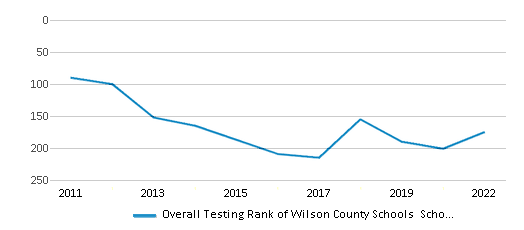
Math Test Scores (% Proficient)
47%
51%
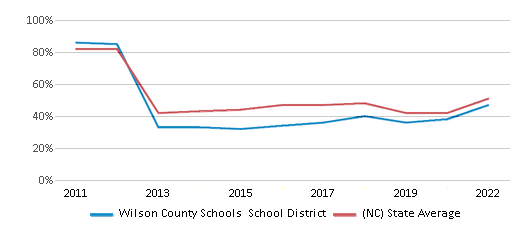
Reading/Language Arts Test Scores (% Proficient)
48%
50%
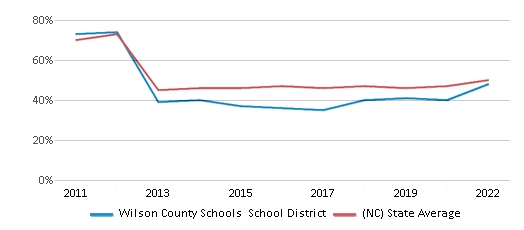
Science Test Scores (% Proficient)
60%
63%
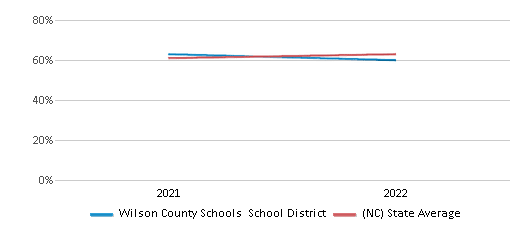
Graduation Rate
79%
86%

Students by Ethnicity:
Diversity Score
0.69
0.71
# American Indian Students
22 Students
5,633 Students
% American Indian Students
n/a
1%
# Asian Students
151 Students
19,933 Students
% Asian Students
1%
4%
# Hispanic Students
2,468 Students
98,873 Students
% Hispanic Students
24%
20%
# Black Students
4,303 Students
122,407 Students
% Black Students
42%
25%
# White Students
2,834 Students
215,701 Students
% White Students
28%
44%
# Hawaiian Students
12 Students
646 Students
% Hawaiian Students
n/a
n/a
# Two or more races Students
470 Students
30,848 Students
% of Two or more races Students
5%
6%
Students by Grade:
# Students in PK Grade:
137
1,882
# Students in K Grade:
777
16,660
# Students in 1st Grade:
787
16,806
# Students in 2nd Grade:
841
17,050
# Students in 3rd Grade:
698
16,530
# Students in 4th Grade:
714
16,849
# Students in 5th Grade:
695
19,618
# Students in 6th Grade:
770
111,560
# Students in 7th Grade:
766
116,793
# Students in 8th Grade:
732
119,029
# Students in 9th Grade:
1,030
12,380
# Students in 10th Grade:
847
10,877
# Students in 11th Grade:
771
9,420
# Students in 12th Grade:
651
8,569
# Ungraded Students:
-
-
District Revenue and Spending
The revenue/student of $11,920 is higher than the state median of $11,187. The school district revenue/student has stayed relatively flat over four school years.
The school district's spending/student of $11,236 is less than the state median of $11,612. The school district spending/student has stayed relatively flat over four school years.
Total Revenue
$122 MM
$17,307 MM
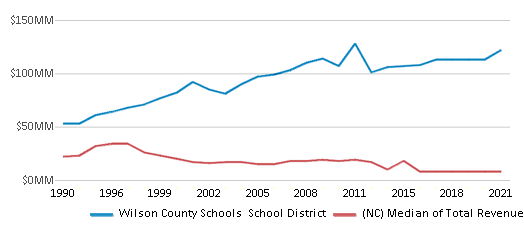
Spending
$115 MM
$17,964 MM
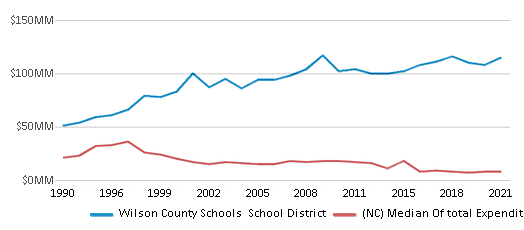
Revenue / Student
$11,920
$11,187
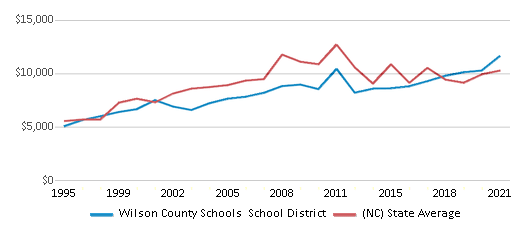
Spending / Student
$11,236
$11,612
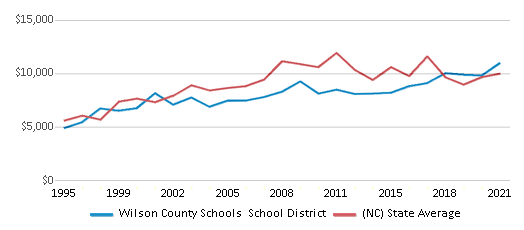
Best Wilson County Schools School District Public Middle Schools (2025)
School
(Math and Reading Proficiency)
(Math and Reading Proficiency)
Location
Grades
Students
Rank: #11.
Wilson Academy Of Virtual Education
(Math: 60-69% | Reading: 70-79%)
Rank:
Rank:
9/
Top 20%10
117 Ne Tarboro St
Wilson, NC 27894
(252) 399-7700
Wilson, NC 27894
(252) 399-7700
Grades: 4-12
| 51 students
Rank: #22.
Elm City Middle School
(Math: 51% | Reading: 59%)
Rank:
Rank:
7/
Top 50%10
215 E Church St
Elm City, NC 27822
(252) 236-4148
Elm City, NC 27822
(252) 236-4148
Grades: 6-8
| 425 students
Rank: #33.
Springfield Middle School
(Math: 56% | Reading: 53%)
Rank:
Rank:
7/
Top 50%10
5551 Wiggins Mill Rd
Lucama, NC 27851
(252) 239-1347
Lucama, NC 27851
(252) 239-1347
Grades: 6-8
| 462 students
Rank: #44.
Forest Hills Middle School
(Math: 46% | Reading: 44%)
Rank:
Rank:
5/
Bottom 50%10
1210 Forest Hills
Wilson, NC 27893
(252) 399-7913
Wilson, NC 27893
(252) 399-7913
Grades: 6-8
| 626 students
Rank: #55.
Speight Middle School
(Math: 33% | Reading: 49%)
Rank:
Rank:
4/
Bottom 50%10
5514 Old Stantonsburg Road
Stantonsburg, NC 27883
(252) 238-3983
Stantonsburg, NC 27883
(252) 238-3983
Grades: 6-8
| 281 students
Rank: #66.
Charles H Darden Middle School
(Math: 16% | Reading: 29%)
Rank:
Rank:
1/
Bottom 50%10
1665 Lipscomb Road
Wilson, NC 27893
(252) 206-4973
Wilson, NC 27893
(252) 206-4973
Grades: 6-8
| 389 students
Rank: #77.
Milton M Daniels Learning Center
Alternative School
(Math: ≤5% | Reading: 10-14%)
Rank:
Rank:
1/
Bottom 50%10
723 Elvie Street
Wilson, NC 27893
(252) 399-7900
Wilson, NC 27893
(252) 399-7900
Grades: 3-12
| 73 students
Recent Articles

What Is A Charter School?
Explore the world of charter schools in this comprehensive guide. Learn about their history, how they operate, and the pros and cons of this educational innovation. Discover key facts about charter schools, including admission policies, demographics, and funding, as well as what to look for when considering a charter school for your child.

10 Reasons Why High School Sports Benefit Students
Discover the 10 compelling reasons why high school sports are beneficial for students. This comprehensive article explores how athletics enhance academic performance, foster personal growth, and develop crucial life skills. From improved fitness and time management to leadership development and community representation, learn why participating in high school sports can be a game-changer for students' overall success and well-being.

February 05, 2025
Understanding the U.S. Department of Education: Structure, Impact, and EvolutionWe explore how the Department of Education shapes American education, from its cabinet-level leadership to its impact on millions of students, written for general audiences seeking clarity on this vital institution.





